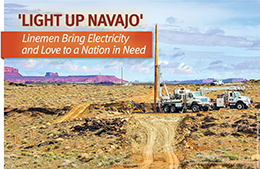
In the sacred story of the birth of the Navajo Nation, the first holy people rose through three worlds before emerging into the splendor of their homeland in what would become the American Southwest. They called it the Glittering World.
Their landscape sparkles against brilliant blue skies, bookended by sunrises and sunsets that turn towering red rock formations, canyons, mountains, lakes, forests and high desert into majestic works of art.
But inside thousands of the homes dotting the Nation's 27,000-square miles, it is dark.
No lights. No working refrigerators or microwave ovens. No TVs, computers or cell phone chargers. No modern conveniences beyond what some residents minimally fuel with small generators a couple of hours a day.
Roughly 15,000 of the 55,000 families living on the reservation never have had electricity. Their homes comprise 70% of all dwellings in the United States without it.
But last spring, thanks in large part to IBEW members, the lights went on in 233 of those homes. Hundreds more will be hooked up later this year during the second phase of a mammoth project called Light Up Navajo.
It has been life-changing for the Navajo people and linemen alike.
"When they turn the first switch and they can finally use the microwave, the mini fridge, they're crying, we're tearing up," journeyman lineman Matt Scirpoli said. "I'm so proud I could be part of it."
Eager to Volunteer
Scirpoli, of Worcester, Mass., Local 486, was among dozens of IBEW members around the country who traveled in spring 2019 to the Navajo Nation to work alongside electricians from the Navajo Tribal Utility Authority.
The territory, larger than West Virginia, sprawls across the adjoining corners of Arizona, New Mexico and Utah. Roughly 190,000 residents — about two-thirds of the Navajo population — live on the reservation at any given time.
Density averages 4.2 houses per square mile. But many are spread farther apart, making the work of installing utility poles and stringing wire more labor-intensive and time-consuming than is typical for line crews.
Utilities and municipalities, such as the City of West Boylston in Massachusetts, where Scirpoli works, paid regular wages and travel expenses to send eager volunteers, many of them staying two weeks. Linemen happily worked to exhaustion, 12 to 14 hours a day, usually six days a week.  |
 Print
Print  Email
Email
